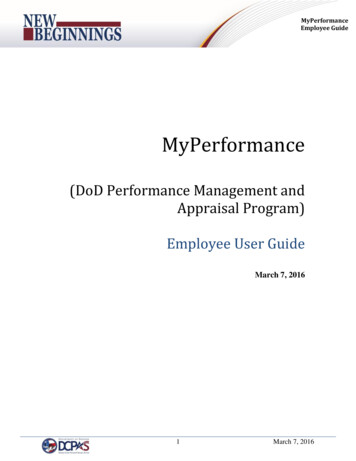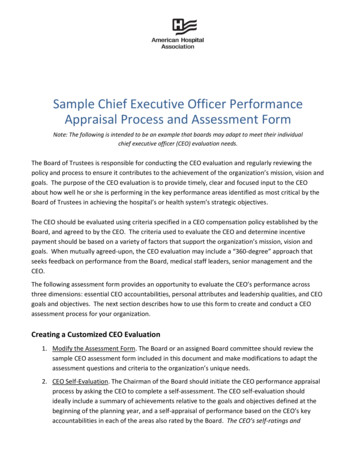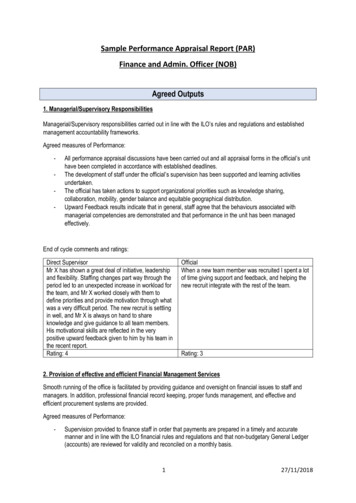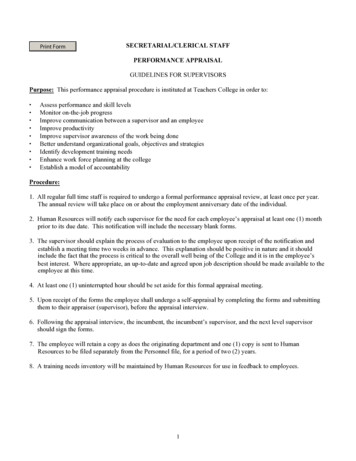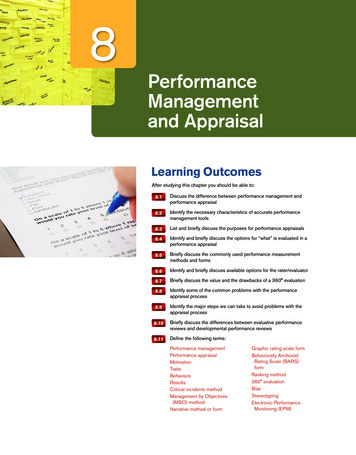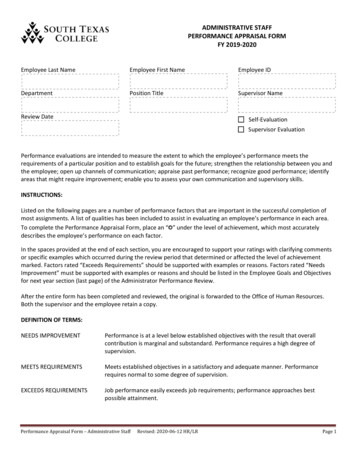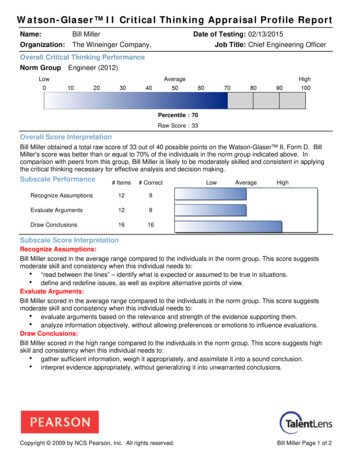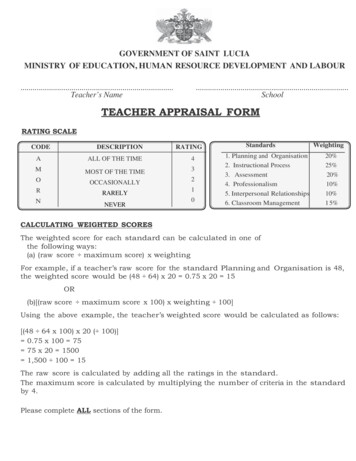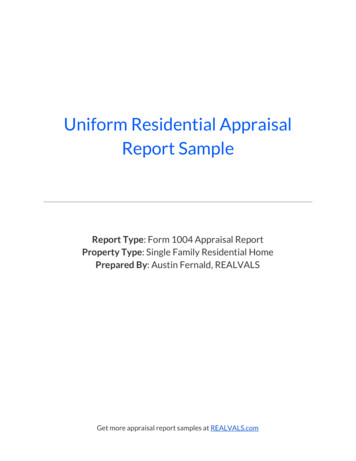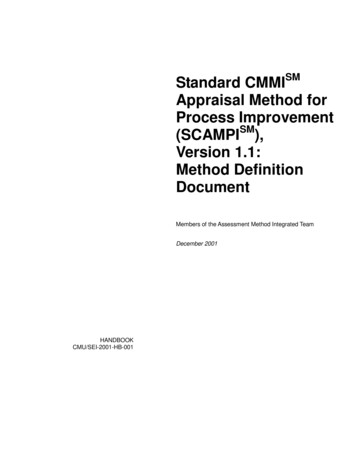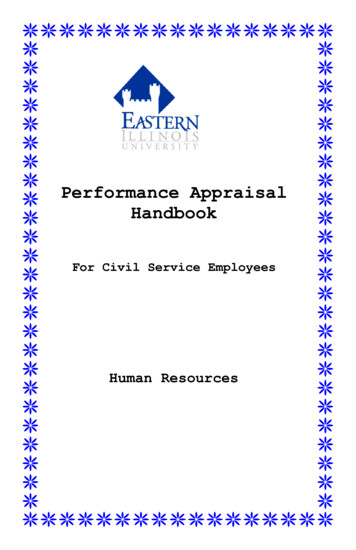
Transcription
Performance AppraisalHandbookFor Civil Service EmployeesHuman Resources
Performance Appraisal Definition - 3 Uses - 3 Performance Standards - 4 Rating Definitions - 5 Performance Goals - 5 Rating Errors - 6 Rating Cycle - 7 The Performance Review - 8 Appraisal Process - 9 Evaluate the System - 11 Appraisal Checklist - 12page2
Performance Appraisal DefinedPerformance appraisal provides a periodic review andevaluation of an individual's job performance.Although the appraisal forms may only be completed once ayear, the job of performance appraisal is continuous – sometimesdaily - and requires effective communication on both the part ofthe supervisor and the employee. The supervisor is ultimatelyresponsible to make sure these conversations actually take placeand are documented.It is essential that the supervisor hold all performancediscussions and documentation in complete confidence.Oneemployee’s performance should never be discussed with anotheremployee. This action is one of the best ways for a supervisor tolose the trust of all employees.The completed Performance Appraisal forms are maintainedin the employee’s personnel file in Human Resources and arereleased only to the employee, the supervisor or other personsauthorized by law, regulation, or policy.UsesPerformance appraisal has many uses, but perhaps the mostimportant is that it provides employees with critical feedback withwhich they can improve their performance.Without yourfeedback, your employee may have a difficult time figuring outwhat you want done differently.It also provides supervisors with critical feedback with whichthey can help employees improve their performance and often alsoprovides supervisors with ideas on how they can become a bettersupervisor.Training needs should be identified during performancediscussions.If an employee is having trouble completingassignments, you should always investigate whether you havepage3
provided the employee with all necessary training for the tasks.Just because other employees may not have needed additionaltraining, doesn’t mean none of them need training.The University may use completed performance appraisalsfor many things, including: 1) determining the promotability ofemployees; 2) validating tests used for recruitment and selection;3) evaluating the training program to find areas where additionaltraining needs to be offered; and possibly 4) to determine meritpay when applicable.Employees who wish to have theirperformance appraisals reviewed by potential supervisors forconsideration for a new position need to make sure HumanResources is aware of their wishes.As an employee, you should use your performance to help youplan your career and assess strengths and weaknesses to identifypotential job growth.Since performance evaluations may also be used in legaldisputes, it is essential that the information entered is truthful,accurate and based on performance, not personalities, rumors, oropinions.The annual performance appraisal must NOT be the solebasis for initiating formal discipline. When employee performancerequires correction, it is the supervisor’s job to identify theproblem, discuss it with the employee, and document the discussionas soon as the correction is identified. There should be nosurprises during the annual discussion.Performance StandardsPerformance standards are what we use to differentiatebetween acceptable and unacceptable behavior. The standards areidentified for each of the job elements and explain whatsatisfactory performance will look like. Written justification mustbe provided for any rating of “Outstanding,” “Unacceptable,” or“Needs Improvement.” The employee should have been notifiedpage4
well before the formal annual appraisal if they will be rated lessthan “Meets Expectations”.Ratings DefinitionsUse the following as a general guide when determining yourratings for each item:Unacceptable: A standard of performance well belowminimum requirements; not effectiveNeeds Improvement: A standard of performancegenerally below acceptable standards; needs developmentMeets Expectations: A standard of performancemeeting all normal requirements of the positionExceeds Expectations: A standard of performancegenerally exceeding expected results; above averageOutstanding: A standard of performance leaving noconsequence to be desired; highest possible effectivenessPerformance Goals (SMART)Performance goals must have certain characteristics in orderto be effective. Goals must beS) SpecificM) MeasurableA) AttainableR) RelevantT) TimelyBe sure goals and objectives are clearly connected to thedepartment or University strategy or mission/vision.page5
Rating ErrorsIt is the supervisor’s responsibility to ensure thePerformance Appraisal accurately reflects the performance of theemployee. Rating employees on their performance alone is noteasy. Most raters (even the best) make many common mistakes.If you are going to have an effective rating system, you must avoidmaking any of the following rating errors:1)Halo/Horn - allowing perceptions of performanceon one rating dimension to affect the rating of all performancedimensions. An employee who has difficulty working with othersmay rate very high in dependability or job knowledge.2)Leniency/Severity - Rating easy or harshregardless of performance. This is usually done with employees weespecially like or employees we may not like so much. Be sure torate the performance, not how we feel personally about the person.3)Central Tendency - Rating everyone averageregardless of performance. This takes a lot of responsibility offthe supervisor’s shoulders as it is difficult for any one to complainsince no one got either a very good or a very bad rating. It couldalso mean rating the same employee average in all behaviors or jobelements.4)Contrast Effect - comparing employees with oneanother. Remember that you rate each employee’s performanceagainst the job description—not how they compare with otheremployees, or how they compare with the last employee in that job.5)Primacy/Recency - First impression and memoryerrors. We remember best what we see either first or last. Thisis a good reason to keep an event record/log. Using this methodshould eliminate this error along with several others mentionedabove.6)Escalation of Commitment - as familiarityincreases commitment increases. Once we have made up our mindabout an employee – good or bad – it is difficult to change ouropinion. We look for good behavior in good employees and we lookpage6
for bad behavior in bad employees. We continue to look for andonly see behavior that supports our opinion.7)Self-fulfilling Prophecy - managers who hireemployees usually want them to succeed. It is a good reflection onthe manager. At the same time, managers may not expect successfrom an employee that someone else selected. It is also easy toput too much credence in what others have told you about anemployee. We look for performance that supports our beliefs anddisregard performance that is contrary to our beliefs.8)Bias - value systems affect opinions. For example,it may be difficult to consider someone of a different religion orethnic group as being a good person, and so it may be difficult torate them as a good employee.9)Stereotyping – If we consider a certain group ofpeople as hard working then we may tend to rate anyone in thatgroup as being highly productive even if they are not.10)Glass Ceiling Effect – The supervisor maysometimes decide when an employee has reached their peakperformance and stop challenging the employee to continue toimprove.Rating CycleThe formal Performance Appraisal Form must be completedannually. At the beginning of the rating cycle, the supervisor andemployee must review the blank form and identify which five, six,or seven Job Elements will be rated; which Position-SpecificFactors will be rated; and identify goals or objectives to becompleted during the rating cycle. For employees on probation, thesupervisor must complete both the Midpoint and Final EmployeeEvaluation Records and return them to the Employment Office inHuman Resources. When you complete these forms, take theopportunity to have a formal performance discussion with your newemployee. Be sure the final form is turned in before the end ofthe probationary period.page7
Civil Service appraisals should be done on a periodic basiscovering approximately 12 months. The beginning of the fiscal yearis typically the beginning of the Civil Service Appraisal period formost employees. For new employees, the appraisal period maybegin at the completion of probation or the date the employee isassigned. In these cases, the period might not be 12 months.Completed Appraisal forms are due to Human Resources within 30days of the end of the rating cycle; generally at the end of thefiscal year.The Performance ReviewGet ReadyWhen getting ready to conduct a performance discussion, itis important that you allow sufficient time for your discussion.Remember to allow time for the employee to talk at least as muchas you plan to. Schedule the discussion for a time and place whereyou will not be distracted by the phone or visitors and you both willnot feel intimidated.Get SetBe sure to notify the employee ahead of time so they haveample time to complete the Employee Worksheet and think aboutwhat they will want to discuss. You should also make sure theemployee has the most recent copy of the Event Record/Log. Eventhough both forms are optional, they are great ways for both thesupervisor and employee to document work experience that coversthe Performance Appraisal period.GoWhen you are ready to conduct the discussion, be sure youspend more time listening than talking. Ask the employee for avariety of input, including: solutions for problems, what they thinkthey can do to improve their own performance, and be sure to askhow you can help your employee improve.page8
Your employee needs feedback from you on how they areperforming at their job. Just as you appreciate feedback fromyour supervisor -- so do your employees. Feedback is necessaryfor correcting errors. Individuals normally have an inherent driveto self-evaluate, which means they seek feedback as a basis forcomparing themselves to others.Feedback also reducesuncertainty which is a cause of stress because they are not surewhat you want from them. Consistent feedback reduces stress forboth you and your employee.Finally, review the appraisal forms including the EventRecord/Log and the completed Employee Worksheet (hyperlinkedabove), and the Performance Appraisal Form. At the conclusion ofthe discussion, you can finalize the form and notify the employeewhen you are ready for them to sign it.Appraisal ProcessIn the BeginningAt the beginning of the rating cycle you and your employeemust reach an understanding of how the appraisal process is goingto proceed. You should begin by reviewing the position descriptionand determining which Position Specific Factors will be used toevaluate the employee.Although you need to discuss thisinformation with the employee, you need to get their input andthen make the final decision. You might want to select the areawith the greatest percentage of time assessed to it, or you maywant to select one that is very critical to the success of theemployee. In any case, you should select the areas that you wantthe employee to concentrate on during the cycle because “whatgets measured gets done.”You also need to determine which of the Job Elements will berated. You may want to rate all of the elements or you may decidethat up to two of the elements are not important for this job andpage9
leave them out of the evaluation. Again, although you will discussthese factors with your employee, you must make the finaldecision.The last thing you will need to do is determine and documentgoals for the employee. Once it is clear how the employee will beevaluated, you should both sign the form and you should give theemployee a copy.During the cycleAs the year progresses, you need to have regular contactwith your employee so you can actually see for yourself what isgoing on and discuss it with the employee as needed. Make regularentries in the Event Record/Log (hyperlinked above) and discusseach entry with your employee. You should include both positiveand negative events. Address any problems as they come up andtake any necessary action to correct them. As you make entries inthe log, be sure to provide a copy to the employee.30 days and countingAbout 30 days before you plan to conduct your annualappraisal discussion, meet with the employee and make sure theyare aware of the scheduled meeting time and place, and have acopy of all documentation that is expected to be discussed duringthe formal performance appraisal. Give the employee a blank copyof the Employee Worksheet (hyperlinked above) and ask them tocomplete it and bring it with them to the meeting.The Day has Comepage10
On the day of the appraisal discussion, review all the formstogether with the employee. You may use the Checklist at the endof this booklet as a guide for the discussion. Remember to reviewperformance – not personalities. Discuss and document next year’sgoals, position specific factors and job elements before you aredone with the meeting. If you have followed the steps up to now,addressed problems as they occur and discuss performanceregularly with the employee, this meeting should be a smoothprocess.When the Appraisal is DoneAfter your appraisal meeting you should formalize the formaccording to the discussion, 1) record the employee’s signature onthe form; 2) provide a copy to the employee; and 3) forward theoriginal copy to your department director for signature andforwarding to Human Resources.Evaluate the SystemNow that you have completed a cycle, you should evaluate thesystem to be sure your employee understands the feedback and tosee if there is a positive change in performance as a result of theappraisal.page11
Appraisal Interview ChecklistDid you discuss each goal or objective established?Are you and the employee clear on the areas of agreement anddisagreement?Did you and the employee cover all positive skills, traits,accomplishments, areas of growth, etc.? Did you reinforce theemployee’s accomplishments?Did you give the employee a sense of what you thought of his orher potential or ability?Are you both clear on areas where improvement is required?Expected? Demanded? Desired?What training or development recommendations did you agreeon?Did you indicate consequences for noncompliance, ifappropriate?Did you set objectives for the next appraisal period?Did you set a time for the next performance discussion?Did you confirm what your part would be? Did the employeeconfirm his or her part?Did you thank your employee for his or her efforts?page12
performance and stop challenging the employee to continue to improve. Rating Cycle The formal Performance Appraisal Form must be completed annually. At the beginning of the rating cycle, the supervisor and employee must review the blank form and identify which five, six, or
